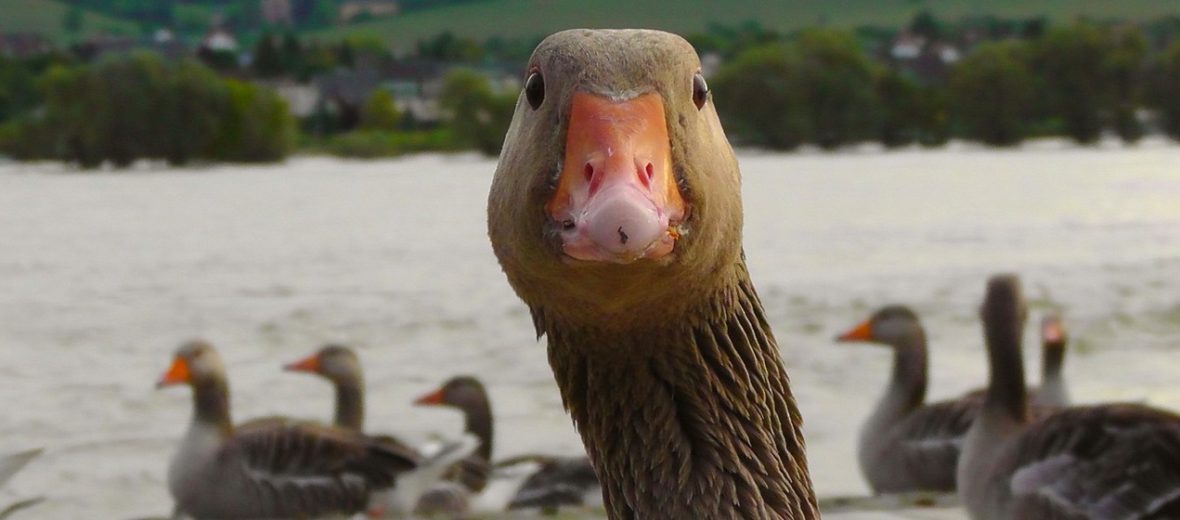
The goose is a common term used to describe several waterfowl species in the family Anatidae. There are numerous species of geese in the world, yet the most common are termed as grey, white, and black geese. These are not to be confused with the distant relatives of the Anatidae family: swans; which tend to be larger than common geese. The 3 main colorations, as mentioned above, are generally listed as Least Concern by the IUCN, as they are quite abundant.
First the Stats…
Scientific name: Anser
Weight: Up to 7.3+ lbs.
Length: Up to 3.6 feet
Wingspan: Up to 6.1 feet
Lifespan: Up to 24 years
Now on to the Facts!
1.) Males are typically called a gander. Females are called a goose. The newly hatched geese are called goslings.
2.) A group of geese is called a gaggle, skein, team, wedge, or plump.
3.) The word “goose” hails directly from, “*ghans-“. In Germanic languages, the root gave way to Old English “gōs” with the plural “gēs” and “gandres” (this later became the Modern English goose, geese, gander, and gosling).
4.) True geese have been around for roughly 10 million years, which dates back to the Miocene Epoch.
5.) The appropriately named Anser atavus (meaning “progenitor goose”) hails from approximately 12 million years ago had more plesiomorphies in common with today’s swans.
But wait, there’s more on the goose!
6.) The goose tends to be monogamous (mates for life).
7.) While paired, they can become very territorial and aggressive during mating season and when protecting their eggs.
Did you know…?
Geese will honk in flight to help encourage other members of the flock to maintain their famous ‘V-formation’ and to assist in communication with each other.
8.) When geese fly in that V-formation, do you know why 1 line is longer than the other? It’s because there are more geese in that line. [dad joke]
9.) Geese don’t always migrate for the winter. Some only fly as far south as it takes to find adequate amounts of food and fresh water.
10.) Due to being easier prey, when Europeans came to North America, they nearly wiped out the entire population of geese. Thanks to captive breeding and mass reintroduction efforts, their populations have bounced back.
But wait, there’s still more on the goose!
11.) The geese that do migrate, will molt before they descend southward. During this molting period, they are unable to fly and are quite vulnerable, till their new feathers come in. They will tend to stick near water, during this time, for protection.
12.) Goslings are able to fly south by fall.
Did you know…?
For orientation, migrating geese use earth’s magnetic field, landmarks, and past experience.
13.) In preparation for migration, geese will tend to gorge themselves.
14.) The most commonly found Canada goose can travel up to 1,500 miles, in just 24-hours!
15.) “What’s good for the goose is good for the gander” means that what is an appropriate treatment for 1 person is appropriate for someone else. This statement which supports equality is typically used in the context of sex and gender, due to the fact that a goose is female and a gander is male.
But wait, there’s still a little more on the goose!
16.) Geese lay up to 11 eggs each season.
17.) The eggs are laid at a rate of 1, every 1.5 days, and incubation starts with the first laid egg.
Did you know…?
Geese have serrated edges on their tongues that resemble teeth. This gives them the appearance of having a pharyngeal jaw (third jaw).
18.) Eggs hatch in up to 28 days.
19.) Bears, coyotes, eagles, foxes, gulls, ravens, wolverines, and wolves all prey on geese.
20.) Bromegrass, clovers, bluegrass, orchard grass, timothy, and small insects are all on the menu for geese.
Now a Short Goose Video!
Be sure to share & comment below! Also, check out the Critter Science YouTube channel. Videos added regularly!
Want to suggest a critter for me to write about? Let me know here.



